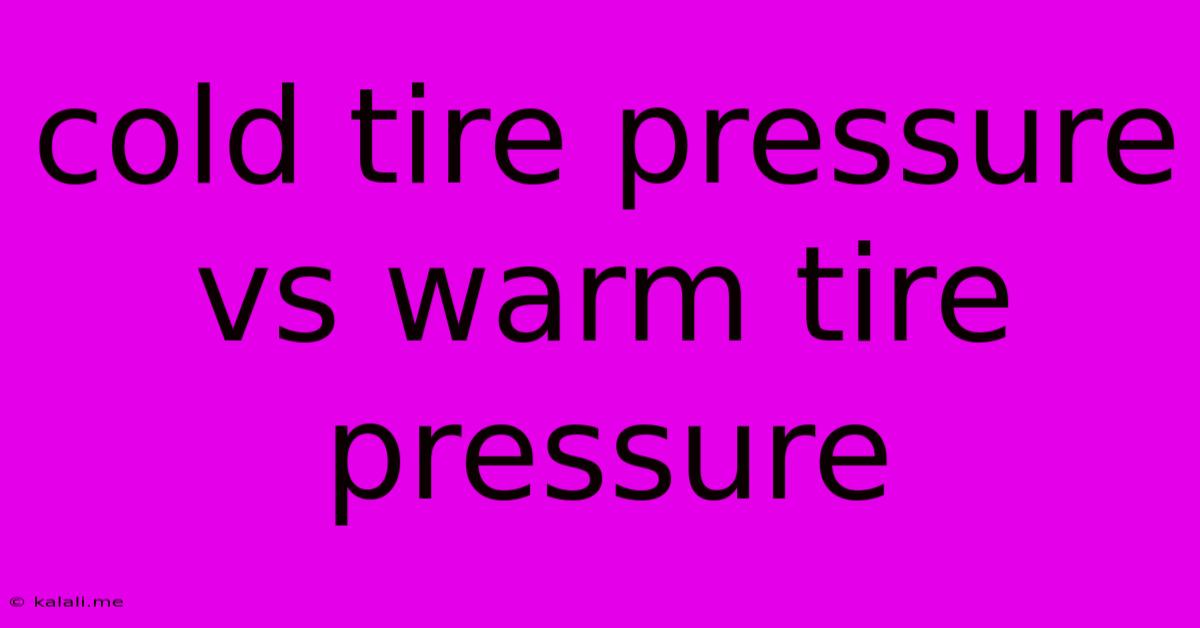Cold Tire Pressure Vs Warm Tire Pressure
Kalali
Jun 03, 2025 · 3 min read

Table of Contents
Cold Tire Pressure vs. Warm Tire Pressure: Understanding the Difference and Why It Matters
Maintaining the correct tire pressure is crucial for your safety, fuel efficiency, and the longevity of your tires. But have you ever noticed that the recommended tire pressure listed on your driver's side door jamb or in your owner's manual is different from the pressure you read after a drive? This is because tire pressure changes with temperature. Understanding the difference between cold and warm tire pressure is key to keeping your tires properly inflated. This article will delve into the nuances of cold vs. warm tire pressure, explaining why the distinction is so important.
What is Cold Tire Pressure?
Cold tire pressure refers to the tire pressure reading taken when the tires have been sitting for at least three hours, or haven't been driven for several miles. During this time, the tire's internal air hasn't been significantly heated by friction with the road. This is the most accurate reading and the one you should use to check against the recommended pressure. The recommended pressure is typically found on a sticker located on the driver's side doorjamb or in your owner's manual. This recommended pressure is always a cold tire pressure.
What is Warm Tire Pressure?
Warm tire pressure is the reading you get after driving for a significant distance. The friction between the tires and the road generates heat, causing the air inside the tires to expand. This expansion increases the pressure reading. The amount of pressure increase depends on several factors including the length of your drive, the speed you were traveling, and the ambient temperature.
Why the Difference Matters: The Impact of Temperature on Tire Pressure
The ideal tire pressure is crucial for optimal vehicle handling, fuel economy, and tire life. Driving on under-inflated tires leads to increased rolling resistance, potentially resulting in:
- Reduced fuel efficiency: More energy is needed to move the vehicle, leading to lower gas mileage.
- Increased wear and tear: Uneven tire wear due to improper inflation.
- Compromised handling: Reduced grip and increased risk of accidents.
- Potential tire failure: Underinflation significantly increases the risk of a blowout.
Conversely, overinflation also presents issues:
- Reduced ride comfort: A harsher ride, impacting passenger comfort.
- Uneven tire wear: The center of the tire wears out faster.
- Increased risk of tire failure: Overinflation weakens the tire structure, making it more susceptible to damage.
Checking Your Tire Pressure: The Right Way
To ensure accurate readings and maintain optimal tire pressure, follow these steps:
- Check pressure when tires are cold: Always check your tire pressure first thing in the morning or after the vehicle has been parked for at least three hours.
- Use a reliable gauge: A quality tire pressure gauge is essential for accurate readings.
- Refer to the recommended pressure: Consult the sticker on your driver's side doorjamb or your owner's manual for the recommended cold tire pressure.
- Adjust pressure as needed: Add or release air as needed to reach the recommended pressure.
Addressing the Myth of "Warm Tire Inflation"
Many people mistakenly believe that they should inflate their tires to the recommended pressure after driving. This is incorrect. Always inflate your tires to the recommended cold tire pressure. Any pressure increase after driving is a natural consequence of the heat generated by friction, not a sign that you need to inflate your tires further.
Conclusion: Consistent Monitoring is Key
Regularly checking your tire pressure – always using a cold tire pressure reading as your baseline – is a simple yet crucial maintenance task. By understanding the difference between cold and warm tire pressure, and by diligently monitoring and adjusting your tire pressure as needed, you can ensure optimal performance, safety, and longevity of your tires. Remember to check your tire pressure regularly, ideally once a month, or more frequently if you frequently drive long distances or in extreme temperatures.
Latest Posts
Latest Posts
-
2023 Qualified Dividends And Capital Gains Worksheet
Jun 05, 2025
-
Wire Size For 400 Amp Service
Jun 05, 2025
-
How Long Does A Mi Hike Take
Jun 05, 2025
-
Change Subject Expression Starts With An
Jun 05, 2025
-
How To Hide Someone On Snap
Jun 05, 2025
Related Post
Thank you for visiting our website which covers about Cold Tire Pressure Vs Warm Tire Pressure . We hope the information provided has been useful to you. Feel free to contact us if you have any questions or need further assistance. See you next time and don't miss to bookmark.